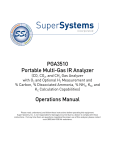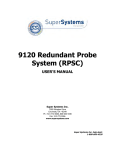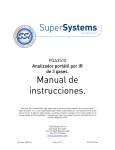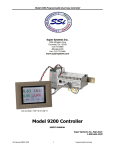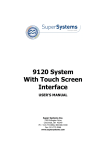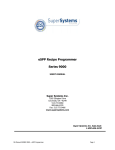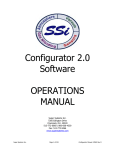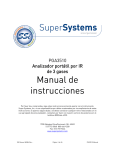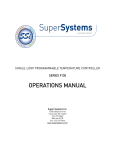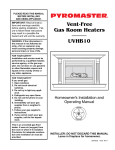Download Operation Manual - Whaley Food Service
Transcript
Operations Manual PGA 3510 Portable 3-Gas IR Analyzer Please read, understand, and follow these instructions before operating this equipment. Super Systems, Inc. is not responsible for damages incurred due to a failure to comply with these instructions. If at any time there are questions regarding the proper use of this analyzer, please contact us at (800) 666-4330 for assistance. 7205 Edington Drive Cincinnati, OH 45249 513-772-0060 800-666-4330 Fax: 513-772-9466 www.supersystems.com SSI Manual #4584 Rev. - Page 1 of 20 PGA3510 Operations Manual Table of Contents Table of Contents................................................................................................................ 2 Introduction......................................................................................................................... 3 Specifications...................................................................................................................... 3 Basic Operating Description ............................................................................................... 4 Pump Operation .................................................................................................................. 5 Carbon Calculation ............................................................................................................. 5 Menu Lists .......................................................................................................................... 7 Sessions............................................................................................................................... 8 PUMP CONTROL............................................................................................................ 10 SENSOR CALIBRATION ............................................................................................... 11 Performing a Zero Calibration ...................................................................................... 12 Performing a Span Calibration...................................................................................... 12 Calibrating the Oxygen Sensor ..................................................................................... 12 Automatic Sampling Parameters....................................................................................... 13 Minimum Temperature for sampling............................................................................ 14 Minimum Millivolts for sampling ................................................................................ 14 Minimum Millivolt Condition… .................................................................................. 14 COF/PF Adjustment Increment .................................................................................... 14 COF/PF Adjustment Interval (minutes)........................................................................ 15 COF/PF Adjustment Delay after Pump On (secs) ........................................................ 15 Minimum COF / PF Value............................................................................................ 15 Maximum COF / PF Value ........................................................................................... 15 COF / PF Adjustment Mode ......................................................................................... 15 Communications Setup ..................................................................................................... 15 IP Address..................................................................................................................... 16 Set RS485 Communications ......................................................................................... 16 Port Usage..................................................................................................................... 16 Port Baud Rate .............................................................................................................. 16 Probe Temp/mV Instrument Type ................................................................................ 16 Probe Temp/mV Instrument Address ........................................................................... 17 Furnace Temp Instrument ............................................................................................. 17 Furnace Temp Instrument Address............................................................................... 17 Furnace Temp Source Instrument................................................................................. 17 Port Setup...................................................................................................................... 17 Instrument Setup ........................................................................................................... 17 Calculation Factors ........................................................................................................... 17 IR Shim Factor.............................................................................................................. 18 CH4 Factor.................................................................................................................... 18 General Setup.................................................................................................................... 18 Security Settings ........................................................................................................... 18 Factory Default Settings ............................................................................................... 18 Instrument Information ................................................................................................. 18 General Information...................................................................................................... 18 Calibration Dates .......................................................................................................... 18 SSI Manual #4584 Rev. - Page 2 of 20 PGA3510 Operations Manual Power Status ................................................................................................................. 18 Tools ................................................................................................................................. 19 Database Maintenance .................................................................................................. 19 Maintain Equipment Types........................................................................................... 19 Maintain Equipment...................................................................................................... 19 Maintain Sessions ......................................................................................................... 19 Maintain Users .............................................................................................................. 19 Compact Database ........................................................................................................ 19 Pressure Sensor Calibration .......................................................................................... 19 Thermister Calibration .................................................................................................. 19 SuperCalc...................................................................................................................... 19 User Manual.................................................................................................................. 20 Set User Cal / Load User Cal........................................................................................ 20 Introduction The Model PGA3510 is a portable 3-Gas IR analyzer with an Oxygen (O2) cell. It measures Carbon Monoxide (CO), Carbon Dioxide (CO2) and Natural Gas (CH4) typically found in an endothermic atmosphere. Specifications The unit is designed and manufactured for the atmosphere heat treating industry, however it’s uses go beyond the scope of these applications. CO range: CO2 range: CH4 range: O2 range: 0.00 to 30.00 % 0.000 to 2.000 % 0.00 to 15.00 % 0.1 to 25.0% * Note: These sensors have been optimized for use at the levels normally seen in Endothermic atmosphere. The ranges can be adjusted to fit other applications. For information regarding modifications to the ranges shown above, please contact the factory. Sampling method: Accuracy and repeatability: Flow Meter: Pump Operation: AC Power: DC Power: Communications: Data Storage: Data Retrieval: Operating Temperature: Dimensions: Weight: SSI Manual #4584 Rev. - Extraction by internal pump (when necessary) ± 1% of full scale Inside case lid and also on-screen On/Off/Automatic 90 to 230 VAC, 50 to 60 Hz, 60 Watts 12VDC rechargeable NiCd battery with Integral charger Ethernet, USB(A), USB(B), RS485 Continuous automatic data logging XGA Viewer Software (included) or on-screen 32° to 122° F (0° to 50° C) Approx. 16”H X 20”L X 8”D Approx. 30 lbs. Page 3 of 20 PGA3510 Operations Manual Basic Operating Description The Model PGA 3510 has been designed for the simultaneous analysis of CO, CO2 and CH4 in heat-treat furnace atmosphere gases. It uses a color touch screen display / operator interface for data entry and for viewing. Selections can be made on the screen using a finger or a stylus. Do not use objects such as screwdriver tips or ink pens on the screen since they can potentially cause permanent damage. When the instrument is powered on, it will take approximately 30 seconds for the PGA3510 software to automatically load. After that the instrument is ready to use. When the power switch is turned off, the instrument initiates a controlled shutdown procedure which takes about 15 seconds. After the controlled shutdown period, the instrument will completely turn off. When the power switch is turned on, the PGA3510 will initiate the startup procedure. When finished, the main screen will be displayed: F A J B K C H G I D A – Measured values of CO, CO2, and CH4 B – Pump status indicator / Button for change pump status C – Button to access menu list D – Button to Carbon Calculation screen E – Button for Trend Chart screen F – Visual Flow indicator G – Numeric flow indicator H – Session status indicator I – Gas Temperature / Instrument Temperature indicator J – External instrument Communications status indicator K – Automatic Carbon Calculation Adjustment indicator L – Measured value of Oxygen SSI Manual #4584 Rev. - Page 4 of 20 L E PGA3510 Operations Manual This screen is the default screen for the PGA3510. This screen can be accessed from any other screen by pressing the “go back” or “Return” button at the bottom right of any screen. Depending on the screen, it may be necessary to press this button more than once. Pump Operation On startup, the pump will be off. When sampling an endothermic generator or any other gas under positive pressure, the pump should remain off. For proper operation, there should be between 1.0 and 2.0 SCFH of gas flowing through the sensors. If the flow meter at the right of the screen or on the inside of the lid does not indicate sufficient flow, the pump should be turned on. When accessed from the main screen, the pump has three possible modes. The pump will always be on when On, and always off when Off. When in Automatic mode, the instrument will evaluate the temperature and probe millivolts to determine if they are within acceptable user-defined limits. By setting limits that are appropriate to the process being measured, the pump will only be on during times when a sample is desired. For more information on this feature please see the “Sampling Parameters” section. Carbon Calculation The PGA3510 measures the percent carbon in the measured gas by using the percentages of CO, CO2, and CH4, in addition to the Furnace Temperature that must be entered by the user. It is also possible to determine the percent crbon of the gas as measured by the Oxygen probe by entering the Probe Temperature, Probe Millivolts, and the Probe CO Factor. It is not necessary to enter the information from the probe to determine the percent carbon as measured by the SSI Manual #4584 Rev. - Page 5 of 20 PGA3510 Operations Manual gas analyzer. Entering the probe information does allow for a comparison to be made between the percent carbon as measured by the Gas Analyzer and by the Oxygen Probe. The PGA3510 will then be able to suggest a change to the probe CO Factor (or Process Factor depending on the manufacturer) that will allow the probe to measure the same carbon level as the gas analyzer. Measurement of the percent carbon using infra-red analysis is generally considered to be a superior method to determining the percent carbon when compared to an Oxygen Probe alone. This is because the Oxygen Probe is measuring the amount of Oxygen in the gas, and then inferring the percent carbon by assuming a theoretical mixture of endothermic gas. Instead of inferring this mixture, the gas analyzer will exactly measure the composition of the gas to determine the percent carbon. SSI Manual #4584 Rev. - Page 6 of 20 PGA3510 Operations Manual Menu Lists Accessing the menu screen will show three available options. Carbon Calculation, Sessions, and Instrument Information can be accessed by any users. Additional menu items are available when an authorized user logs in using an appropriate Pass Code. When the Supervisor Pass Code is entered (default = 1), the user will also be able to access the Pump Control screen. To see the full range of options available, the user must use the Configuration Pass Code (Default = 2). This provides the user with all available options including calibration and setup functions. SSI Manual #4584 Rev. - Page 7 of 20 PGA3510 Operations Manual To go to any of the items on the menu list, touch the item to highlight it and then press Select. A specific description of each item on the list is shown below: Sessions The instrument is logging data any time that it is powered on. This data can be viewed by entering the date and time of the data of interest. Sessions allows for a more user-friendly method of viewing and recalling data by allowing the user to apply tags to sections of data. These tags can include the name of the operator and the name of the equipment that is being measured. The instrument has default values for each of these variables, but it is highly recommended that the selections be modified to reflect conditions at the specific facility where it will be used. This will allow for the data to be tagged in a way that is easily recognized by any member of your organization. For more information on how to set up these selections with custom entries, see the “Tools – Database Management” section of this manual. SSI Manual #4584 Rev. - Page 8 of 20 PGA3510 Operations Manual Using the pull-down menus, select the User Name and Equipment Name from the list of available selections. Then begin the session by pressing Start. After confirming that you would like to begin a session, you will see a sessions summary screen. To end the session, press the red End button. SSI Manual #4584 Rev. - Page 9 of 20 PGA3510 Operations Manual This screen will identify sessions between the date range specified at the top of the screen. As a default is shows sessions from the past 24 hours, but by expanding the data range additional sessions can be seen. These sessions are sorted with the newest entry at the top, but they can be sorted by End Time, Equipment Name, or Operator Name by touching the header of each column. To see the details of any session highlight it by touching it, and then press Detail. This will take you to a graphical representation of the data from the selected session. To leave the Chart view, press the red X in the upper right hand corner of the screen. PUMP CONTROL The Pump Control screen shows different options than the pump button on the main page. This screen can be viewed by editing the Pump Status line. SSI Manual #4584 Rev. - Page 10 of 20 PGA3510 Operations Manual In addition to the pump status, the pump delays can also be set on this screen. These delays are only enabled when the pump is in automatic mode (see the Automatic Sampling Parameters screen). SENSOR CALIBRATION Two types of calibrations can be performed on the NDIR sensor; Zero and Span. The Zero calibration should be performed with a gas that has none of the measured gases in it. Ideally this would be pure Nitrogen or Argon. The concentration of the Span calibration gas should closely resemble the gas that is being measured. For a heat treating application measuring endothermic gas, the ideal composition would be: CO: 20% CO2: 0.5% CH4: 5.0% H2: 40% N2: Balance Since the accuracy of the calibration gas directly influences the resulting accuracy of the instrument, the highest possible accuracy grade should be obtained. Some gas suppliers refer to this as a “Certified Primary Standard”. The high degree of accuracy is not required to obtain nominal values that exactly match the values shown above. The accuracy is required to know the exact composition of the gas in the cylinder. The actual composition will be shown on the bottle when it is delivered. When flowing calibration gas into the analyzer, the pump should be off. The amount of flow from the gas cylinder should be approximately 1.5 SCFH at no pressure. The gas cylinders will be under high pressure, so it is recommended that a two stage regulator with a low pressure SSI Manual #4584 Rev. - Page 11 of 20 PGA3510 Operations Manual secondary stage should be used. It is good practice to begin the flow of gas before attaching the calibration gas to the instrument. This will prevent any high pressure bursts from entering the instrument. Performing a Zero Calibration On the Sensor Calibration screen, be sure that the button at the upper right of the instrument is selecting Zero Calibration and not Span Calibration. When this is selected, the target values will automatically go to zero. Begin the flow of gas at the appropriate rate, and allow the readings to come to equilibrium. This occurs when the actual values are not moving in a specific direction and they display only slight movements up and down. This should take approximately 45 seconds. There is a column showing the Status of each gas. In this area the instrument is making a comparison between the Target value and the Actual value and providing feedback based on the amount of difference between the two. There are three possible words that can appear in this area: “OK” – The gas is within 10% of where it is expected to be. “OK?” – The gas is between 10% and 20% of where it is expected to be. This could indicate an issue with the calibration gas, so the calibration gas and the associated tubing should be checked and verified to be free from leaks or improper gas composition. This message does not necessarily indicate that there is a problem with the sensor or the calibration. It is meant only to have the operator make sure that the proper procedures are being followed. “BAD” – The gas is more than 20% from where it is expected to be. The same items should be checked as described above. This message could indicate an issue with the sensor. Regardless of the status of each of the gases, the instrument can be calibrated by waiting for the readings have stabilized and pressing Start Calibration. Timers will begin to count down, and when they reach zero the Actual values should be the same as the Target values. They may not be exactly the same but they should be very close. If desired, the calibration can be performed again to get the readings closer to the Target values. Performing a Span Calibration A Span calibration is performed the same way as the zero calibration with two small changes. First, the selector button at the top should be on Span Calibration instead of Zero Calibration. Second, the gas values for the specific cylinder of gas that is being used need to be entered into the Target values. This is done by pressing the blue box associated with each gas and entering the value as it is shown on the cylinder. For example, the nominal value for CO may be 20%, but your cylinder may actually have 19.967% CO. This is the value that should be entered as a target. Calibrating the Oxygen Sensor The Oxygen Sensor can be calibrated by pressing the Calibrate O2 button from the Sensor Calibration screen. For this calibration, there is no Zero Calibration required. The span gas that should be used for calibrating the Oxygen sensor is ambient air. Do not use the zero gas or span gas from the IR sensor calibrations to calibrate the Oxygen sensor. Bring the instrument to an office or outdoors where it will be in fresh air. Air has 20.9% Oxygen so it is a reliable gas to use for calibrating the sensor. SSI Manual #4584 Rev. - Page 12 of 20 PGA3510 Operations Manual When the Oxygen Calibration screen is entered, the pump automatically turns on. When the Actual value stabilizes, press them Start Calibration button. This will make the Actual value match the target value. Automatic Sampling Parameters This instrument is capable of communicating directly with a control instrument. To establish this communications link, see Communications Setup – Set RS485 Communications. This will allow it to directly read the information from the Oxygen Probe and, if desired, make modifications to the COF/PF. SSI Manual #4584 Rev. - Page 13 of 20 PGA3510 Operations Manual Minimum Temperature for sampling When the probe temperature is greater than or equal to this temperature, and the Adjustment Mode is set to COF/PF Adjust, the instrument will perform automatic updates to the COF or PF. When the temperature drops below this set point no adjustments will take place. In addition to determining when to make adjustments, this value also determines the temperature at which the pump will turn on to enable sampling. Pump control will only take place if the Pump Mode is set to “Automatic”. This prevents the instrument from pulling a sample when the conditions are not right, which can prevent water from being accidentally pumped into the instrument and also increasing the pump life by only running it when necessary. The on and off delays set on the Pump Control screen will apply. Minimum Millivolts for sampling This provides the same safeguards as the Minimum Temperature, but it is based on the Millivolts measured by the probe. This will prevent damage if the furnace is kept hot but is being purged of process gas. Minimum Millivolt Condition… The operator can determine if control of the pump should be based on the millivolt level. If the pump should turn on and off using the same criteria as the Minimum Millivolts for Sampling, this should be set to Also Stops Pump. COF/PF Adjustment Increment When adjustments are made automatically, this value indicates the size of the step that is made when the COF/PF is changed. It is recommended that this number remain low to avoid making sudden changes to the process that could be caused by temporary conditions. SSI Manual #4584 Rev. - Page 14 of 20 PGA3510 Operations Manual COF/PF Adjustment Interval (minutes) This indicates the frequency that automatic adjustments are made. We recommend making small changes at a frequent interval instead of making large changes at longer intervals. This will prevent sudden changes from occuring. COF/PF Adjustment Delay after Pump On (secs) There may be times when adjustment should be temporarily inhibited after the pump turns on. Examples of this may be after a probe burnout or after a door opens or closes. Delaying the adjustment will allow the temporarily nonconforming gas to be purged from the instrument before any adjustments are made. Minimum COF / PF Value As a safeguard, the COF/PF can be prevented from dropping below a certain point. This point is the Minimum COF/PF value. Maximum COF / PF Value The Maximum COF/PF can also be entered as a safeguard. COF / PF Adjustment Mode This selection determines if changes to the COF/PF should be made automatically or if the instrument should only monitor the conditions and not make any changes. When in Monitor mode, a COF/PF will continue to be suggested, but no modifications will be made to the atmosphere controller. Communications Setup This screen allows the user to view and modify the method of communications between the instrument and external devices. SSI Manual #4584 Rev. - Page 15 of 20 PGA3510 Operations Manual IP Address This allows the user to set the IP address, Net Mask, and IP Gateway for the sensor inside the instrument. These can be modified as necessary to establish communication between the instrument and an external SCADA system. The sensor is accessed through the Ethernet port on the side of the case. The touch screen IP Address is also shown on this screen although at this time there is no method of communicating directly with the screen. Set RS485 Communications RS485 communications can be set up to automatically enter and update data from the oxygen probe and, if desired, make modifications to the COF/PF in the atmosphere controller. Port Usage This is the communication method used to supply information to the instrument. To change the port usage, enter a number between 0 and 2. The possible values are: Modbus Master Modbus Host Port Baud Rate This is the speed of communications which can range between 1200 and 115200. Probe Temp/mV Instrument Type This is the make and model of the device that will be supplying the instrument with information on: probe temperature, probe millivolts, and COF/PF. Possible choices are: SSi AC20 Yokogawa UDP750 Honeywell UDC3300 SSI Manual #4584 Rev. - Page 16 of 20 PGA3510 Operations Manual Dualpro Loop 1 Modbus Dualpro Loop 2 Modbus SSI 9200 Loop 1 Probe Temp/mV Instrument Address This is the address of the atmosphere controller. It can be directly entered using the numeric keypad on the touch screen. Furnace Temp Instrument This is the make and model of the device that will be supplying the instrument with information on furnace temperature. If there is no instrument associated with this input, the probe temperature will be used. Possible selections are: SSi AC20 Yokogawa UDP750 Honeywell UDC3300 Dualpro Loop 1 Modbus Dualpro Loop 2 Modbus SSI 9200 Loop 1 SSI 9200 Loop 2 SSI 9200 Loop 3 SSI 9100 Loop 1 Furnace Temp Instrument Address This is the address of the furnace temperature instrument. It can be directly entered using the numeric keypad on the touch screen. Probe Temp/mV Source Instrument This line displays the status of communications with the Temperature / Millivolt instrument. The message is automatically generated and cannot be adjusted by the operator. Furnace Temp Source Instrument This line displays the status of communications with the Temperature / Millivolt instrument. The message is automatically generated and cannot be adjusted by the operator. Port Setup This page is used to set the parameters for the communications ports. The factory default settings are shown above, and they should not need to be changed by the operator. Instrument Setup The items shown in this menu list are settings that should only need to be changed once. Any modifications to the default values will be saved in the instrument. Calculation Factors There are two items that will influence the calculation of carbon – the IR Shim Factor and the CH4 Factor. These values should only be changed after determining that additional adjustments are required based on the specific conditions and equipment at your facility. Neither of these items should be modified without significant testing or consultation from Super Systems, Inc. SSI Manual #4584 Rev. - Page 17 of 20 PGA3510 Operations Manual IR Shim Factor Changing the IR Shim Factor is a way of modifying the computed percent carbon. The nominal value is 180. There is an inverse relationship between the IR Shim Factor and computed percent carbon. To increase the computed percent carbon this number should be lowered, and to decrease the computed percent carbon it should be increased. CH4 Factor This factor increases or decreases the significance of CH4 in the calculation of carbon. CH4 does not have a significant impact on the computed percent carbon, so it has a minor role in the equation. If the measured gas has over 5% CH4, it’s role in the equation becomes greater than it should be. In these cases the CH4 factor should be reduced. In cases where the CH4 is present in excess of 7 or 8%, this factor can be reduced to zero. General Setup On this screen the date, time, and temperature units can be set. It is also possible to change the operating language of the instrument from this screen. Security Settings This page is used to change the pass code used for logging into the menu list. The default setting for the Supervisor Pass Code is 1, and the default setting for Configuration is 2. The maximum value for either code is 32767. The Configuration Code will also work for all items on the Supervisor Pass Code items, so entering the Configuration Code (default =2) will give you access to all available menus. Factory Default Settings Selecting this option will cause the instrument to revert back to the settings that it contained when it came from the factory. Any changes or modifications made since then will be lost. Instrument Information These items cannot be modified; they can only be viewed. General Information This is information on the revision levels of various components of the instrument. This can be valuable when consulting with the factory about issues with the instrument. Calibration Dates This area describes the last time the instrument was calibrated at the factory, plus any calibrations that have been performed since then. These dates and times are automatically computed and cannot be manually entered. Power Status This screen will identify the amount of voltage that is available to the instrument and also indicate if the instrument is being charged or not. When plugged in, the Internal Supply Voltage will show the amount of power coming from the internal power supply. When unplugged, the Internal Supply Voltage will indicate the battery voltage. SSI Manual #4584 Rev. - Page 18 of 20 PGA3510 Operations Manual Tools Database Maintenance To make the information recorded during a Session more valuable, the Sessions database should be populated with relevant information regarding the people who will be using the instrument and the equipment that they will be working on. Taking the time to enter this information will provide additional fields to sort by after the data has been collected in a session. Maintain Equipment Types Many of the common types of heat treating equipment have been added into the PGA3510 as default entries. In the event that some of these items are not relevant, or if there are additional pieces of equipment that you would like to add to this list, this can be accomplished on this screen. Maintain Equipment Each organization has different names for the various pieces of equipment in their shop. Those names should be entered here. Each name needs to be associated with a specific Equipment Type, so that database should be populated first. Maintain Sessions The PGA3510 is designed to delete the oldest files first in the event that the storage capacity has been exceeded. It is also possible to delete old files manually by entering a date on this screen. All files that were made before that date would be permanently deleted. It is important to note that after the data has been downloaded to a computer, a copy is stored on that computer. The data will always be available on the computer even if it has been deleted from the screen. Maintain Users The names of all potential users can be entered here. Names can be added and deleted as required. Compact Database Periodic database compaction will help make data storage more efficient and allow more data to be stored before it is automatically deleted. Nothing is deleted or lost when this button is pressed, and the only result will be a performance improvement. Pressure Sensor Calibration The pressure it set at the factory for local conditions. For optimal performance, the ambient pressure should be reset at the final destination. This can be done by determining the barometric pressure and the elevation and entering them on this screen. After the two values have been entered, press the Calibrate button and the pressure sensor calibration will be complete. Thermister Calibration This will be set at the factory and should not need to be adjusted by the end user. SuperCalc SuperCalc is a proprietary software tool developed by SSI to allow the user to perform different scenarios and view the resulting percent carbon. It allows the user to enter gas percentages, SSI Manual #4584 Rev. - Page 19 of 20 PGA3510 Operations Manual probe information, and temperatures to see the effects of each variable on the calculated percent carbon. The data on this screen is independent of any values that are determined by the PGA3510, and it is only provided as a reference tool. User Manual An electronic version of the User Manual is located within the instrument for ease of reference. Set User Cal / Load User Cal This feature allows the user to create new factory default calibration settings for the sensor. Instead of reverting to the factory calibration values, it can revert back to different calibration settings. This is accomplished by first setting the user calibration values. At any time after they are set, they can be restored by selecting Load User Cal. SSI Manual #4584 Rev. - Page 20 of 20 PGA3510 Operations Manual





















